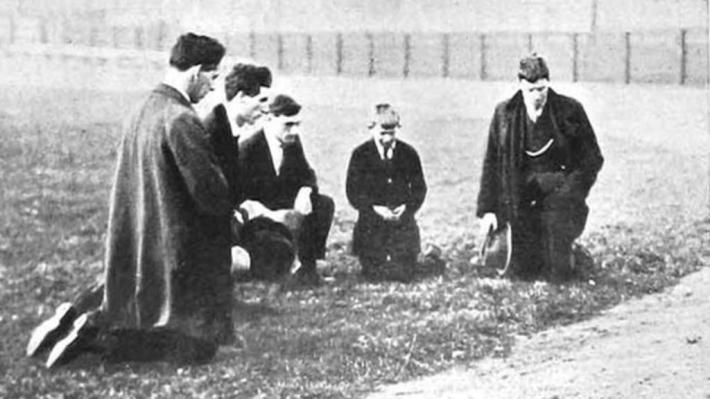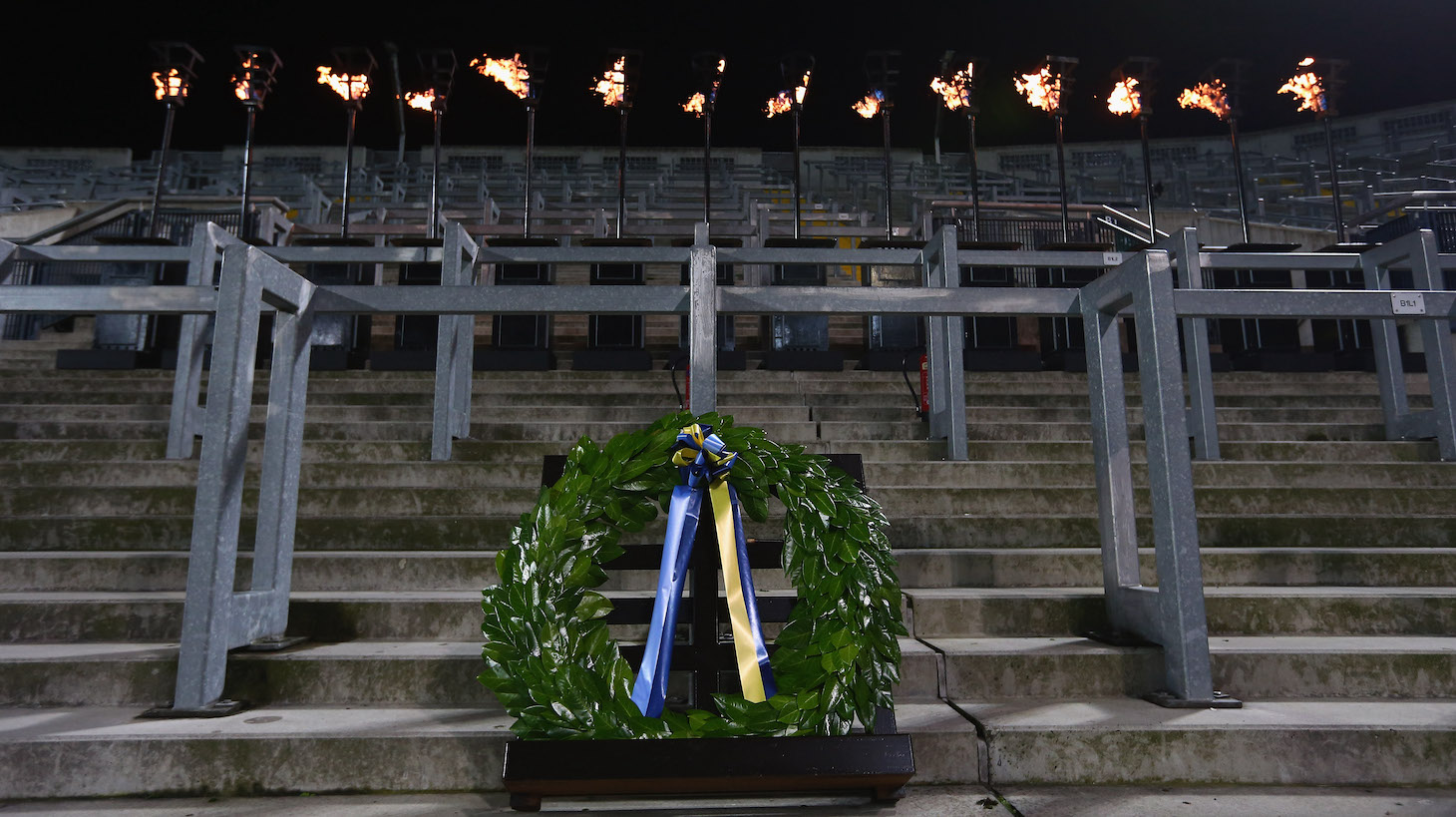On the afternoon of November 21, 1920, an old soldier named Michael Feery left his cottage near Mountjoy Square in Dublin to go to Croke Park and watch a Gaelic Athletic Association football challenge match between teams representing Tipperary and Dublin. Feery had joined the Royal Marines and fought on the Western Front in the First World War. The match wouldn’t start until 2:45, so Feery wore his old military greatcoat and boots against the chill of the late autumn afternoon.
Dublin was on edge. That morning, in a coordinated attack, guerrillas under the command of IRA leader Michael Collins fanned out of the city and systematically decapitated the British intelligence apparatus in the Irish capital. In a single operation, the IRA killed 14 people it had identified as British intelligence operatives. It was one of the most decisive episodes in the War of Independence that had begun in 1919 and it shook the British government in Ireland to its core. Suspicions arose that the gunmen may have planned to melt into the crowd at Croke Park; the GAA was born out of the same burst of Irish nationalism that eventually would lead to the Easter Rising and the birth of the IRA. (In fact, historians now believe that John McDonnell, the goalkeeper of the Dublin side, had been involved in the killing that morning of two British intelligence agents before showing up to play the match. That is one rich, full day.) The money raised at the challenge game would go to a fund that supported the families of Republican prisoners still held in British jails.
In fact, the players and spectators at the match would be a mixed lot; at least one veteran of there British Army would play in the game. Michael Feery, a veteran of the trenches, would have felt the tension in the streets as he walked up to Croke Park. He didn’t need to hurry. The throw-in, scheduled for 2:45, was delayed for a half-hour so that the 15,000 spectators could squeeze into the stadium.
There was a police presence all over the neighborhood. Members of the Royal Irish Constabulary, augmented by the Auxiliaries and the dreaded Black And Tans, were dispatched to search the spectators in order to discover if any of them had been involved in that morning’s attacks. Michael Feery likely didn’t care. He was there to see his Dubs play mighty Tipperary, the eventual 1920 All-Ireland champions, although they wouldn’t be able to win it until 1922, for reasons that will become clear.
In 1920, Tipperary was a power in the GAA. The organization was founded there. It was the first county to win the All-Ireland title in both football and hurling. It also was a hotbed of revolutionary violence. In 1920 alone, 52 people were killed in the county, including 29 victims who were soldiers or police officers. That August, during a game between Tipperary and Clare, British soldiers charged the field, brandishing bayonets and scaring spectators into mass panic. This, as it turned out, was an evil omen. At Croke Park on the afternoon of November 21, 1920, about five minutes after the game had begun, the attention of the spectators was drawn by an airplane that circled above the stadium twice and then fired off a red flare.
As if it were a signal, which it likely was, the police and soldiers surrounding the neighborhood stormed into Croke Park through its southwest gate and opened up on the crowd with rifles and revolvers. When the killing was done, 14 people were dead. They included three schoolboys—10-year-old Jerome O’Leary, 11-year-old William Robinson, and 14-year-old John William Scott—as well as Jane Boyle, a 26-year old who was planning to be married later that week, and Michael Hogan, a Tipperary player who was killed while crawling to cover. Somewhere between 60 and 100 people were wounded.
Despite gunfire meant to keep them inside the stadium, some of the panicked spectators escaped over a high wall near the Royal Canal. Patrick O’Dowd was killed while helping people over this wall. (The last person O’Dowd helped over the wall had O’Dowd’s body fall on top of him on the other side.) Michael Feery undoubtedly saw the plane fire off the flare. He did not survive the afternoon.
There is a Bloody Sunday memorial today in the stands of Croke Park, which now seats 82,000 people and has hosted in its modern incarnation Muhammad Ali, Bruce Springsteen, and the Queen of England. But for decades, the events of November 21, 1920 existed in an odd, airless place in Irish history. As was customary for all but the wealthiest citizens in Dublin at the time, eight of the 14 victims were buried in unmarked graves in a section of Glasnevin Cemetery. In 1925, one of the stands was named for Michael Hogan, the Tipperary player killed on the field. But it wasn’t until 1970 that a memorial of any kind was placed in Croke Park itself. The GAA seemed more intent on remembering the players who had come under fire than on remembering the paying customers who were killed.
Ever since 2016, when the 100th anniversary of the Easter Rising was held, Ireland has been full to overflowing with centennials. Given the nature of the Irish War of Independence, a guerrilla campaign that lacked grand battles like Yorktown or Saratoga, or even semi-conventional engagements like Lexington or Concord, the celebrations have been of the 100-year anniversaries of ambushes and dynamitings and operations like the one launched by Michael Collins on the morning of Bloody Sunday. At virtually the same time, the Brexit vote inflamed relations between Ireland and Great Britain once again, threatening the fragile peace in Northern Ireland established by the Good Friday Agreement. This angry conundrum likely will be exacerbated over the next three years, when the centennials will be not of a War of Independence, but of the brutal (and stupid) civil war that ensued after a peace was made. August 22, 2022 will be the centennial of the death of Michael Collins at the hands of IRA “Irregulars” in Cork. God alone knows what hot words that might occasion.

However, in 2015, an effort was undertaken to place the dead of Bloody Sunday in their proper place in Irish history. Historian Michael Foley, whose The Bloodied Field is the definitive account of the events that day in Croke Park, helped launch the Bloody Sunday Graves Project, which sought to find the unmarked resting places of the victims in Glasnevin and raise gravestones to their memories.
A year ago, on a rainy day in November, the GAA raised memorials in the cemetery where lie a clutch of Irish heroes, including Michael Collins. There was a stone for Jerome O’Leary, who was shot to death before his 11th birthday, and for Patrick O’Dowd, killed while helping other fans to safety. And there was a blue marble headstone raised to Michael Feery who, 100 years ago, lay in the morgue for four days before his wife could come and identify him, and who died at a ballgame that may never have ended.






